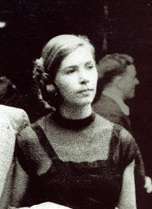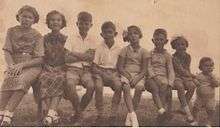Mimi Parent
Mimi Parent (September 8, 1924 – June 14, 2005) was a Canadian surrealist artist. For many years she lived and worked in Paris, France. Her art is known for its symbolism, and the metaphorical use of existing objects, including human hair.[2][3][4]
Mimi Parent | |
|---|---|
 Mimi Parent | |
| Born | Marie Parent September 8, 1924 |
| Died | June 14, 2005 (aged 80) |
| Occupation | Artist |
Early life

Parent was born Marie Parent in Montreal, Quebec.[5] She was the eighth of the nine children of architect Lucien Parent. Between 1942 and 1947 she studied art at the École des Beaux-Arts de Montréal where she met her future husband, fellow art student Jean Benoît.[6] While she was there, she studied under Alfred Pellan who influenced Parent's work.[7] Parent was later expelled from the school after joining a controversial artists' group, called Prisme d’yeux.[7]
Career
In Canada, Parent identified with the Surrealist movement, as well as automatism, and in 1959, she became a member of the Paris Surrealist Group.[8] Parent associated with other surrealist artists, such as Andre Breton and Marcel Duchamp. Parent participated in the International Surrealist Exhibition, devoted to Eros.[8] During 1964–1967, Parent made Anti-Gaullist posters, and she was involved in protests in Paris in May 1968.[7] Parent illustrated books for Guy Cabanel and Jose Pierre.[7]
Parent was most known for her 3D tableaux boxes. In these boxes, Parent would include figures and elements relating to mythology, folklore, and her unconscious imagination.[7] Parent often incorporated elements of lunar and solar forces, representing masculinity and femininity. Parent was raised in a Catholic household, and her work showed influences of her faith and eroticism.[7] Parent incorporated materials such as human hair, in her art objects.[9] One of her well known pieces Maitresse, 1996, was a whip, with the lash being composed of two braids of her hair.[9]
In 1947 she had her first one-woman exhibition at the Dominion Gallery in Montreal which received praise from Time.
In 1948 she received the Cézanne medal.[6] That year she married Benoit, and the two moved to Paris.[10][11] On December 2, 1959, she participated in Jean Benoit's performance, L’Execution du testament du marquis de Sade, a ceremony in which Benoit brands the letters SADE in his chest while dressed with accessories representing Eros and Thanatos. This ceremony established the two as centers of the Parisian surrealist group, led by Andre Breton. Between 1964 and 1967, they participated together in many soirees at the Le Ranelagh theatre in Paris, and in 1965, exhibited at the “L’Ecart absolu” exposition.[12] She exhibited at the "Surrealist intrusion into the Enchanter's Domain" in New York in 1960 and in 1966 had a solo exhibition at the "Maya" gallery in Brussels. She also exhibited in Chicago, London, Lausanne and Frankfurt. She assisted with the organization of the "Exposition inteRnatiOnale du Surréalisme" (EROS), which ran in Paris from December 1959 to the following February; although this is often attributed to Duchamp, she came up with the ideas for the exhibit catalogue, titled Boite Alerte – Missives Lascives, which was presented as a green box into which ideas could be 'posted'.[13]
Parent lived and worked in Paris, France and continued creating art in her later years. Her art medium turned to ink drawings.[7] She had many solo exhibitions throughout her life (Galerie André-François Petit, Paris, 1984; Museum Bochum, 1984; Noyers-sur-Serein, 1992) and was active as an artist until the end of her days. Her most notable shows included Femininmasculin, at the Centre Georges Pompidou in Paris in 1995, La femme Et Le Surrealisme, in Lausanne in 1987, Surrealism: Desire Unbound, at the Tate Modern in London in 2001 and Paris And The Surrealists, in Barcelona in 2005. In the fall of 1998, Galerie 1900–2000 in Paris organized a retrospective of her work and in 2004, the Musée national des beaux-arts du Québec[14] held a retrospective in which she and Jean Benoit were the subjects.[15] She died June 14, 2005 in Switzerland and her ashes were scattered by Benoît at Château de Lacoste, the estate of the Marquis de Sade in Haute-Provence.[16]
References
- "Parent, Mimi". The Canadian Encyclopedia. Archived from the original on March 5, 2016. Retrieved December 21, 2015.
- Laurent Dhennequin; Guillaume Gernez; Jessica Giraud (2009). Objets et symboles: de la culture matérielle à l'espace culturel: actes de la 1re Journée doctorale d'archéologie, Paris, 20 mai 2006. Publications de la Sorbonne. p. 52. ISBN 978-2-85944-622-2.
- Gregory Minissale (October 10, 2013). The Psychology of Contemporary Art. Cambridge University Press. p. 172. ISBN 978-1-107-47009-5.
- Kristoffer Noheden (June 28, 2017). Surrealism, Cinema, and the Search for a New Myth. Springer. p. 144. ISBN 978-3-319-55501-0.
- "Great Works: Maîtresse, 1996, by Mimi Parent" Archived July 4, 2018, at the Wayback Machine. The Independent, Michael Glover, October 27, 2012
- Williamson, Marcus (June 25, 2005). "Mimi Parent, "Incorrigibly wild" Surrealist". The Independent. Archived from the original on March 7, 2019. Retrieved March 6, 2019.
- Mahon, Alyce (July 5, 2005). "Obituary: Mimi Parent". The Guardian. ISSN 0261-3077. Archived from the original on March 6, 2019. Retrieved March 4, 2019.
- Rosemont, Penelope (1998). Surrealist Women: an International Anthology. University of Texas Press.
- Minissale, Gregory (2013). Psychology of Contemporary Art. Cambridge University Press. pp. 166–174.
- "Mimi Parent, artiste surréaliste" Archived March 5, 2016, at the Wayback Machine. Le Monde, June 17, 2005.
- Bill Marshall (2005). France and the Americas. ABC-CLIO. p. 146. ISBN 978-1-85109-411-0.
- Dagen, Philippe (1994). "Le "Premier Artiste"". Romantisme. 24 (84): 69–78. doi:10.3406/roman.1994.5952. ISSN 0048-8593.
- ", 'Boîte alerte' 1959". Tate. Archived from the original on August 12, 2016. Retrieved June 16, 2016.
- "Mimi Parent". www.collections.mnbaq.org. Retrieved January 18, 2020.
- "Mimi Parent | The Canadian Encyclopedia". www.thecanadianencyclopedia.ca. Archived from the original on April 26, 2019. Retrieved March 4, 2019.
- Jean Benoît s'éteint à Paris | René Viau, collaboration spéciale | Arts visuels Archived June 29, 2011, at the Wayback Machine. Cyberpresse.ca. Retrieved on February 25, 2011.
External links
- Obituary in Le Monde (France) by Philippe Dagen
- TheExquisiteCorpse: Mimi Parent